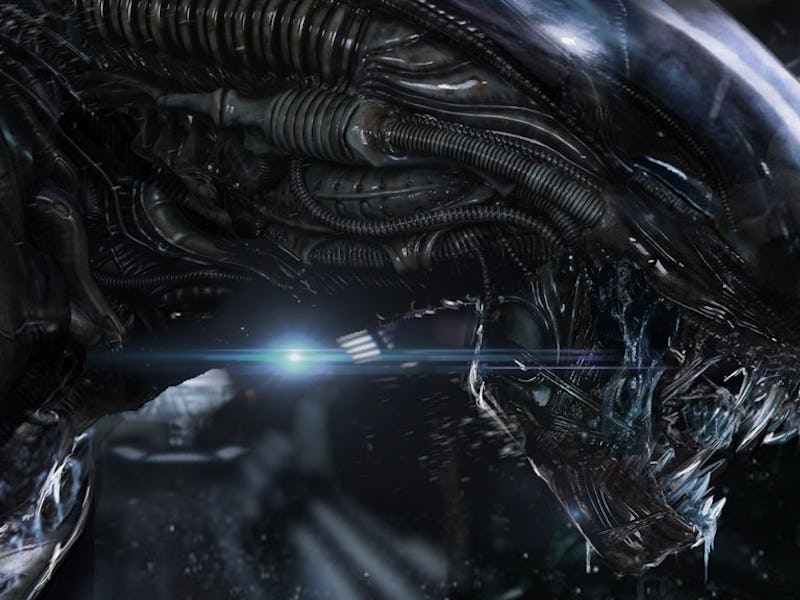'Alien' Xenomorph Biology, Explained
"A perfect organism" with a "structural perfection matched only by its hostility."

The xenomorph from Alien is described by the android crewmember Ash as “a perfect organism” with a “structural perfection matched only by its hostility.”
That was in the 1979 film, the first time we saw the legendary monster created by Swiss surrealist H.R. Giger on-screen. Then, in many subsequent movies, comics, books, and games, we have come to understand a complex biology for the fictional creature. And as the 2017 film Alien: Covenant showed, we’re still learning.
At a high-level, the xenomorph can be understood as a parasitoid, rather than a technical parasite, because it spends a good portion of its life untethered to a host. It is also an arthropod, similar to a cicada or shrimp, with a segmented body, jointed appendages, and a thick, protective exoskeleton. It is also, to quote Ash again, “a survivor, unclouded by conscience, remorse, or delusions or morality.”
But that’s just the start.
Inverse published a guide to xenomorph biology in 2016. We’ve updated it below.
Spoilers follow for various Alien films.
Social Structure
It’s implied in the film that xenomorphs are eusocial, but the Queen’s vision in Aliens confirms it. Xenomorphs protect a central female creature to ensure the continuation of their species. Though a large Queen births young xenomorphs still encased in warm eggs, all xenomorphs display feminine and masculine traits, according to H.R. Giger’s design.
Predatory Tactics
The adult xenomorph is a solitary predator and values the destruction of its prey over cooperation with its kind — though in some cases, as depicted in long sequences, the creatures move as a pack. Rather than feed on humans, xenomorphs often incapacitate prey and transport them to the hive to impregnate the still-live humans with their young. If a particular human reacts violently or doesn’t make a suitable host for the growing young, the xenomorph simply kills that human and moves on.
In Alien Evolution, a documentary charting Alien’s creative process, screenwriter Dan O’Bannon confirmed that the aliens’ use of humans as living hosts was intended to disturb male viewers. The alien life cycle, O’Bannon explained, is not a straightforward depiction of female human pregnancy but of “cross-species homosexual oral rape.”
Line producer Ivor Powell affirmed in an interview that the xenomorph’s primary objective was to inspire sexual horror in the viewer. Based on its physical composition, Powell said, “It could just as easily fuck you before it killed you, [which] made it all the more disconcerting.”
The DNA Reflex
The xenomorph, gestating inside its living host, develops physical traits similar to its host by studying its cellular makeup. Such a response closely resembles the xenomorph’s origins in the virulent mutagenic pathogen known as Chemical A0-3959X.91 — 15, more commonly recognized as the “black goo” prominently featured in Prometheus. Once a living organism is infected in some capacity, the substance causes chaotic mutations in the host’s DNA.
Aliens formed inside humans, for example, burst from human chests and form a bipedal structure, walking on their hind legs like humans would. The “Predalien,” on the other hand — formed inside a Yautja (the titular monster from Predator) — has Yautja-like characteristics. Also, the xenomorph formed using Ellen Ripley’s DNA in Alien: Resurrection has a humanoid skull and exhibits an emotional connection to its mother in a way pure xenomorphs don’t.
In *Alien: Covenant, some crew members are infected with an embryonic spore version of the xenomorph contagion, which develop into the white and more natural-looking neomorph after “blood”-bursting out of random locations on a person’s body. In the movie, that winds up being one person’s throat and another’s back.
It isn’t until several hours after Captain Oram gets face-hugged that a “true” xenomorph is born, though by some accounts, even that protomorph isn’t exactly the same type as the xenomorph in Alien.
But it’s David’s eventual hoarding of the familiar xenomorph eggs at the end of Covenant that many think will lead to the “pure” xenomorph that will eventually show up in Alien to harass Ripley and the crew of the Nostromo.
Basic Senses
According to Alien comics and novelizations, Lasalle Bionational, a fictional research facility, has carried out intricate studies on xenomorph behavior and consciousness. Though xenomorphs don’t have humanoid ears, their long heads are equipped with sensitive segments of flesh which pick up on sound vibrations. Their visual organs are rudimentary according to human scientists in Alien canon, because xenomorphs don’t rely on sight while hunting.
Additionally, xenomorphs don’t give off body heat, and they typically maintain a temperature similar to their environments.
Life Cycle
A fan's rendering of the xenomorph life cycle.
As described by the Alien vs. Predator fan-generated wiki:
The xenomorph life cycle is a complex process comprising several distinct stages. The creature begins its life as an Ovomorph, or Egg, laid by a Queen, which hatches a parasitoid larval form known as a Facehugger, which in turn “impregnates” a living host with an embryo known as a Chestburster. After a gestation period of several hours, the Chestburster erupts violently from the host’s chest, resulting in the death of the host. The Chestburster rapidly matures to an adult phase (within a matter of hours), shedding its skin as it grows and replacing its cells with polarized silicon.
The colloquial terms “facehugger” and “chestburster” originated, of course, from the events of Alien, which visually outlined a xenomorph’s complete lifecycle in detail.
Secretions and Liquids
Xenomorph blood is highly acidic, and injuring a xenomorph allows its inner secretions to burn through human flesh and industrial metals. Though dialogue in Alien calls the blood “molecular acid,” this phrase is actually a tautology, as all acids are made up of molecules. For decades, fans have tried to reason out what a xenomorph’s blood might actually contain, but there has been no canonized confirmation of a molecular structure.
You May Also Like: